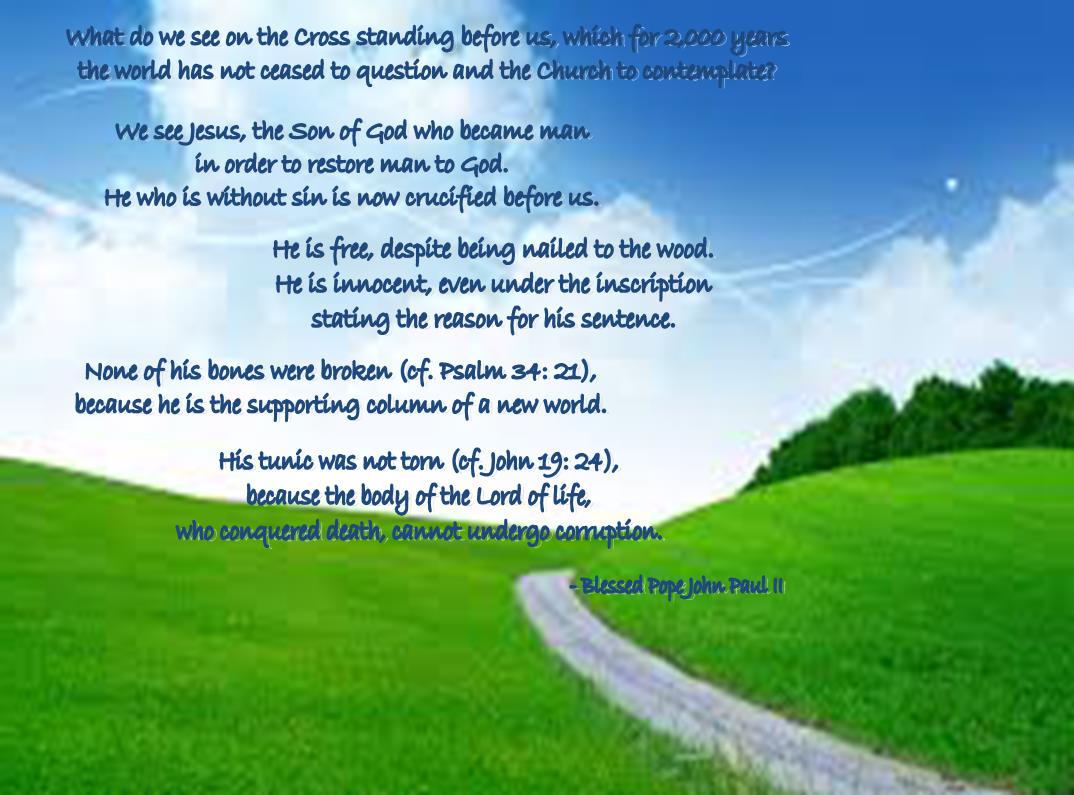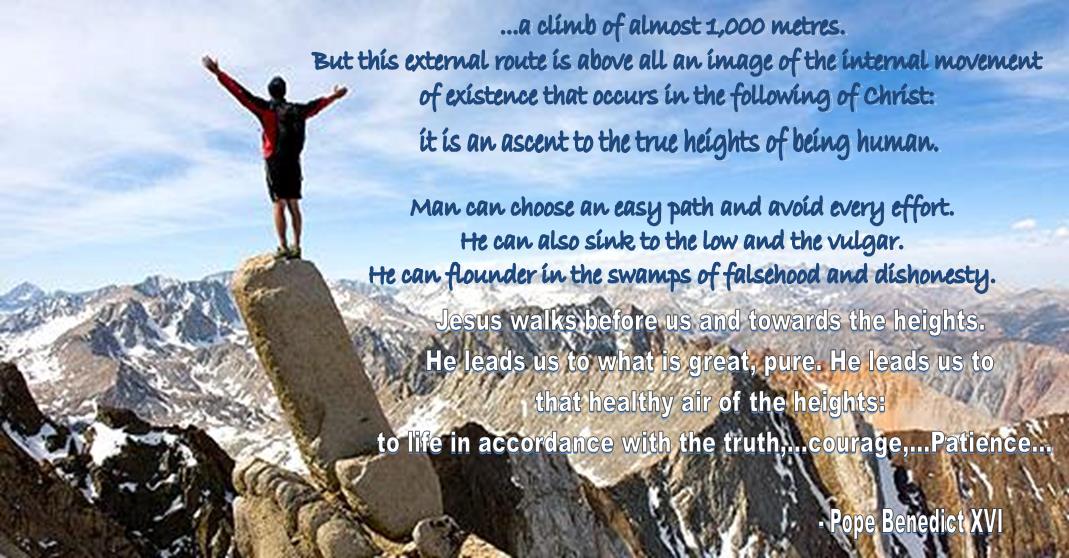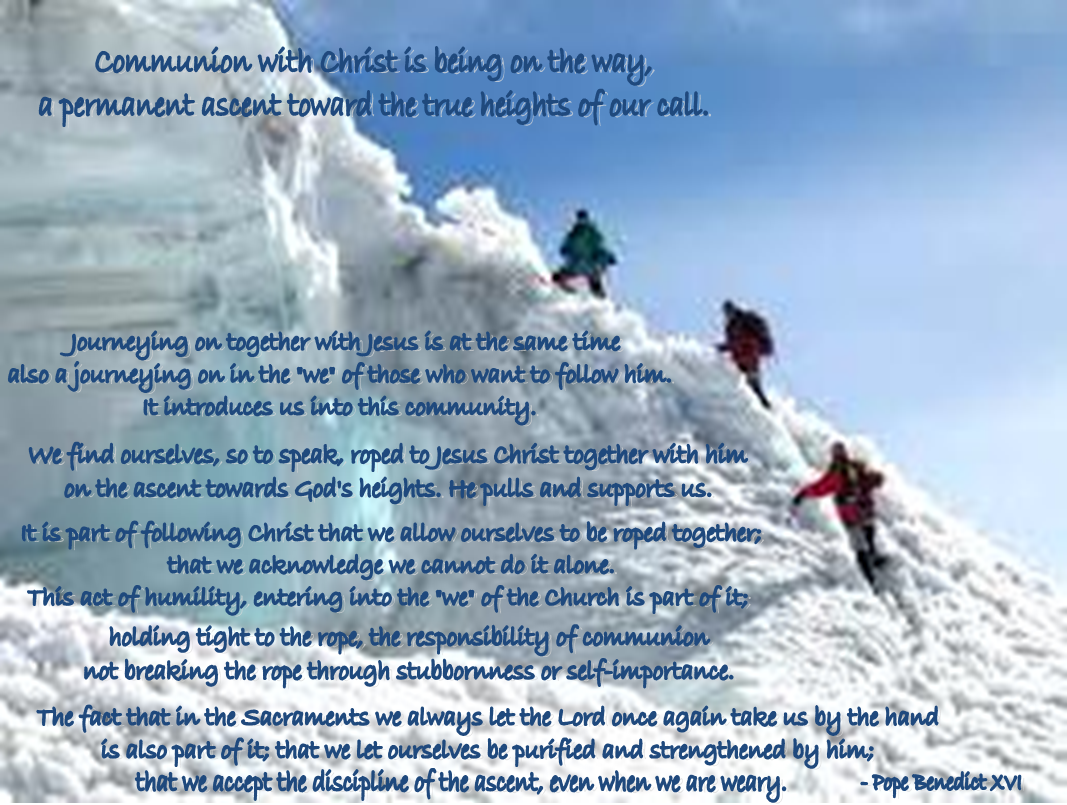
|
4. However, in reading the account of the Passion, the Church does not only consider Jesus' sufferings; she approaches this mystery, trembling yet confident, knowing that her Lord is risen. The light of Easter reveals the great teaching contained in the Passion: life is affirmed through the sincere gift of self to the point of suffering death for others, for the Other.
Jesus did not understand his earthly existence as a search for power, as a race for success or a career, as a desire to dominate others. On the contrary, he gave up the privileges of his equality with God, took the form of a servant, became like men and was obedient to the Father's plan unto death on the cross. Thus he left his disciples and the Church a valuable lesson: "Unless a grain of wheat falls into the earth and dies, it remains alone; but if it dies, it bears much fruit" (John 12: 24).
I particularly greet the young people of the Canadian Delegation, led by Cardinal Ambrozic, Archbishop of Toronto, who are here with us to receive the Cross around which all the young people from every continent will gather on the next World Youth Day in 2002. Once again I forcefully point out to each and every one the Cross of Christ as the path of life and salvation, the way that leads to the palm of triumph on the day of resurrection.
What do we see on the Cross standing before us, which for 2,000 years the world has not ceased to question and the Church to contemplate? We see Jesus, the Son of God who became man in order to restore man to God. He who is without sin is now crucified before us. He is free, despite being nailed to the wood. He is innocent, even under the inscription stating the reason for his sentence. None of his bones were broken (cf. Psalm 34: 21), because he is the supporting column of a new world. His tunic was not torn (cf. John 19: 24), because the body of the Lord of life, who conquered death, cannot undergo corruption.
6. Dear young people, Jesus died and is risen; he now lives for ever! He gave his life. But no one took it from him; he gave it "for us" (John 10: 18). Life came to us through his cross. Through his death and resurrection the Gospel triumphed and the Church was born.
As we confidently enter the new century and the new millennium, dear young people, the Pope repeats to you the words of the Apostle Paul: "If we have died with Jesus, we shall also live with him; if we endure, we shall also reign with him" (2 Timothy 2: 11). For Jesus alone is the Way, and the Truth, and the Life (cf. John 14: 6).
Who shall separate us from the love of Christ? The Apostle has also given us the answer: "I am sure that neither death, nor life, nor angels, nor principalities, nor things present, nor things to come, nor powers, nor height, nor depth, nor anything else in all creation, will be able to separate us from the love of God in Christ Jesus our Lord" (Romans 8: 38-39).
Praise and glory to you, O Christ, Word of God, Saviour of the world!
Acknowledgment: We thank the Vatican Publisher for allowing us to publish the Homily of Blessed Pope John Paul II, so that it could be accessed by more people all over the world; as a source of Godís encouragements to all of us.
CELEBRATION OF PALM SUNDAY OF THE PASSION OF OUR LORD HOMILY OF HIS HOLINESS BENEDICT XVI St Peter's Square (Video)
Dear Brothers and Sisters,
The Gospel of the blessing of the palms that we have heard gathered here in St Peter's Square, begins with the sentence: "[Jesus] went on ahead, going up to Jerusalem" (Luke 19: 28). At the very beginning of today's Liturgy, the Church anticipates her response to the Gospel saying: "Let us follow the Lord". This clearly expresses the theme of Palm Sunday. It is the sequela. Being Christian means considering the way of Jesus Christ as the right way for being human as that way which leads to our destination, to a completely fulfilled and authentic humanity. In a special way I would like to repeat to all young people on this 25th World Youth Day that being Christian is a path or, better, a pilgrimage; it is to travel with Jesus Christ, to journey in the direction he has pointed out and is pointing out to us. |

|
But what direction is this? How do we find it? Our Gospel passage offers two clues in this regard. In the first place it says that it is an ascent. This has first of all a very concrete meaning. Jericho, where the last part of Jesus' pilgrimage began, is 250 metres below sea-level, whereas Jerusalem the destination is located at 740 to 780 metres above sea level: a climb of almost 1,000 metres. But this external route is above all an image of the internal movement of existence that occurs in the following of Christ: it is an ascent to the true heights of being human. Man can choose an easy path and avoid every effort. He can also sink to the low and the vulgar. He can flounder in the swamps of falsehood and dishonesty. Jesus walks before us and towards the heights. He leads us to what is great, pure. He leads us to that healthy air of the heights: to life in accordance with the truth; to courage that does not let itself be intimidated by the gossip of prevalent opinions; to patience that bears with and sustains the other. He guides people to be open towards the suffering, to those who are neglected. He leads us to stand loyally by the other, even when the situation becomes difficult. He leads us to the readiness to give help; to the goodness that does not let itself be disarmed, even by ingratitude. He leads us to love he leads us to God.
Jesus "went on ahead, going up to Jerusalem". If we interpret these words of the Gospel in the context of the way Jesus took in all its aspects a journey which, precisely, continues to the end of time in the destination, "Jerusalem", we can discover various levels indicated. Of course, first of all, it must be understood that this simply means the place, "Jerusalem": it is the city in which God's Temple stood, whose uniqueness must allude to the oneness of God himself. This place, therefore, proclaims two things: on the one hand it says that there is only one God in all the world, who exceeds by far all our places and times; he is that God to which the entire creation belongs. He is the God whom all men and women seek in their own depths, and of whom, in a certain way, they all have some knowledge. But this God gave himself a Name. He made himself known to us, he initiated a history with human beings; he chose a man Abraham as the starting point of this history. The infinite God is at the same time the close God. He, who cannot be confined to any building, nevertheless wants to dwell among us, to be totally with us.
If Jesus, with the pilgrim Israel, goes up to Jerusalem, he goes there to celebrate with Israel the Passover: the memorial of Israel's liberation a memorial which, at the same time, is always a hope of definitive freedom, which God will give. And Jesus approaches this feast in the awareness that he himself is the Lamb in which will be accomplished what the Book of Exodus says in this regard: a lamb without blemish, a male, who at sunset, before the eyes of the children of Israel, is sacrificed "as an ordinance for ever" (cf. Exodix 12: 5-6, 14). And lastly, Jesus knows that his way goes further: the Cross will not be his end. He knows that his journey will rend the veil between this world and God's world; that he will ascend to the throne of God and reconcile God and man in his Body. He knows that his Risen Body will be the new sacrifice and the new Temple; that around him, from the hosts of Angels and Saints the new Jerusalem will be formed, that is in Heaven and yet also on the earth, because by his Passion he was to open the frontier between Heaven and earth. His way leads beyond the summit of the Mountain of the Temple to the heights of God himself: this is the great ascent to which he calls us all. He always remains with us on earth and he has always already arrived with God. He guides us on earth and beyond the earth. |

|
Thus, the dimensions of our sequela become visible in the ascent of Jesus the goal to which he wants to lead us: to the heights of God, to communion with God, to being-with-God. This is the true destination and communion with him is the way to it. Communion with Christ is being on the way, a permanent ascent toward the true heights of our call. Journeying on together with Jesus is at the same time also a journeying on in the "we" of those who want to follow him. It introduces us into this community. Since the way to true life, to being people in conformity with the model of the Son of God Jesus Christ, surpasses our own strength, this journey always means being carried. We find ourselves, so to speak, roped to Jesus Christ together with him on the ascent towards God's heights. He pulls and supports us. It is part of following Christ that we allow ourselves to be roped together; that we acknowledge we cannot do it alone. This act of humility, entering into the "we" of the Church is part of it; holding tight to the rope, the responsibility of communion not breaking the rope through stubbornness or self-importance. Humbly believing, with the Church, like being a roped-party on the ascent towards God, is an essential condition for the following of Christ. This being roped together also entails not behaving as masters of the Word of God, not running after a mistaken idea of emancipation. The humility of "being with" is essential for the ascent. The fact that in the Sacraments we always let the Lord once again take us by the hand is also part of it; that we let ourselves be purified and strengthened by him; that we accept the discipline of the ascent, even when we are weary.
Lastly, we must say again: the Cross is also part of the ascent towards the heights of Jesus Christ, of the ascent to the heights of God. Just as in the affairs of this world it is impossible to achieve great results without self-sacrifice and hard work; just as joy in a great discovery of knowledge or in a true operational skill is linked to discipline, indeed, to the effort of learning, so the way toward life itself, to the realization of one's own humanity, is linked to communion with the One who ascended to God's heights through the Cross. In the final analysis, the Cross is an expression of what love means: only those who lose themselves find themselves.
Let us sum up: the following of Christ requires, as a first step, a reawakening of the desire to be authentic human beings and thus the reawakening of oneself for God. It then requires us to join the climbing party, in the communion of the Church. In the "we" of the Church we enter into communion with the "you" of Jesus Christ and thus reach the path to God. We are also asked to listen to the Word of Jesus Christ and to live it: in faith, hope and love. Thus we are on the way toward the definitive Jerusalem and, from this moment, in a certain way, we already find ourselves there, in the communion of all God's Saints.
Continue next page Ö
|